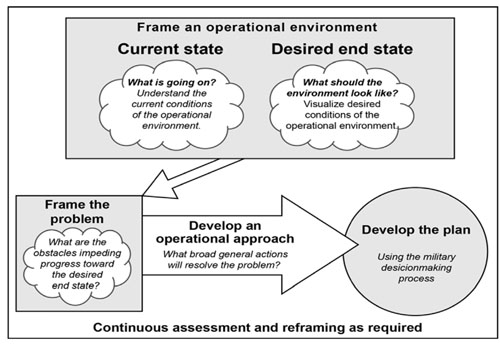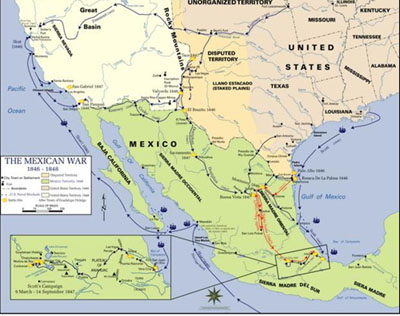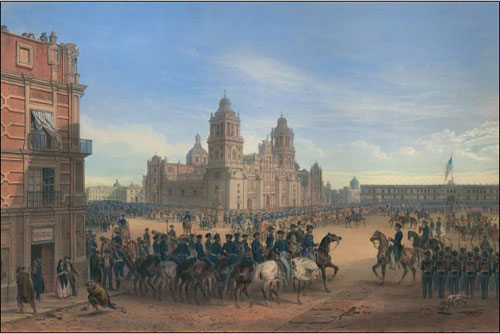To Conquer a Peace: Operational Design in the Mexico City Campaign, 1847-1848
Nathan A. Jennings and Bruce Stanley
In March of 2012, after years of grappling with complex insurgencies in Iraq and Afghanistan, the United States Army codified Army Design Methodology (ADM) into its warfighting doctrine. Defined as “critical and creative thinking to understand, visualize, and describe unfamiliar problems and approaches to solving them,” the concept encouraged and instructed commanders and staffs on ways to broaden their cognitive efforts beyond the traditional boundaries of more detailed and iterative planning processes.[1] While the efficacy of design as a military application remains controversial across the institution, the pairing of conceptual and detailed planning within a single operations process has provided leaders with expanded capacity to understand, and therefore negotiate, unpredictable complexity.
Though newly arrived in Army doctrine, the concept of operational design finds precedent in American military history. The United States’ invasion and occupation of Central Mexico in 1847, for example, featured aspects of it when Major General Winfield Scott, General-in-Chief of the Army, applied relatively sophisticated understanding of the military, geographical, political, cultural, and economic architecture of Latin America’s largest country to the campaign. This approach to planning an amphibious expedition with just 11,000 men against 30,000 fortified defenders amongst a regional population of 2.3 million inhabitants allowed the veteran commander to, as outlined in ADM, frame the operational environment, identify accurate problems, create an operational approach, and construct supporting narratives.[2]
Scott’s understanding of mid-19th century Mexico, though imperfect, stemmed from systemic appreciation of his adversary as a constellation of interacting agents, events, and conditions. As defined by complexity theorists Robert Axelrod and Michael Cohen, this approach interpreted the socially stratified, multi-ethnic, politically fractured, and geographically disconnected Mexican polity as a “complex adaptive system” where “strong interactions among its elements” dynamically “influence the probabilities of many kinds of later events.”[3] The general’s alignment of strategy and tactical actions with national policy, which accounted for interdependences, leverage points, emergence, feedbacks, system structure, and relevant histories, ultimately allowed him to exploit vulnerabilities and negotiate unpredictability to achieve strategic objectives.

The Army Design Methodology process. ADRP 5-0, The Operations Process (Washington, DC: Government Printing Office, May 2012), 2-6.
Operational Design in Mexico
When Scott began planning his littoral expedition in the summer of 1847, the US military had already invaded and occupied Northeast Mexico, New Mexico, and Alto California. Despite rapid successes by armies under Major General Zachary Taylor and Brigadier General Stephen Kearny in frontier provinces, the Polk Administration had begun to realize that it needed to directly threaten Mexico’s more populous interior, and possibly its capital, in order to compel territorial concessions. The general-in-chief, who was then directing the war effort in Washington, DC, accordingly published an analysis paper titled, “Vera Cruz & Its Castle,” that described the strategic situation, challenges, and requirements to “take the city of Mexico, or place it in imminent danger of capture.”[4]
This paper, and general orders and correspondences that followed, established a baseline understanding of the interdependent factors that characterized the continental-wide theater. As required by ADM, it involved “selecting, organizing, interpreting, and making sense of interrelated variables and relevant actors” in order to “frame” the “current state” of the operational environment.[5] Through systemic analysis of the embattled Mexican nation the general identified leverage points that included political instability, financial difficulties, resource challenges, class tensions, religious divisions, and symbolic imperatives for Criollo elites to retain control of Veracruz and Mexico City. He also tactically assessed the port city’s fortifications, the military and economic importance of the 260-mile highway that connected it to the capital, and the peril of coastal operations lagging into the spring yellow fever season.[6]
Scott likewise projected how he had to create a “desired state” in Mexico in order for the ambitious Polk Administration to achieve its limited strategic objectives. This included a Napoleonic theory of war where he envisioned the Mexican government decisively defeated in set-piece battles, Taylor’s and Kearney’s expeditions retaining control of northern provinces, and a new expedition occupying politically sensitive interior spaces. However, the general also recognized the critical importance for Mexico’s national government to remain a viable entity capable of agreeing to, and enforcing, the renunciation of all claims to Texas and the legal transfer of New Mexico, Arizona, and Alto California. This future frame thus precluded more extreme outcomes such as regime change, social revolution, or total annexation.[7]
Based on assessments of current and desired situations, Scott identified how the complex Mexican system could produce emergent, or unanticipated and evolving, problems to prevent the Americans from achieving advantageous political conditions. He first reported to President James K. Polk and Secretary of War William Marcy the enemy perspective, as, “If you come with few, we will overwhelm you; if with many, you will overwhelm yourselves.”[8] The general’s report then outlined known obstacles that included capturing the massive island castle of San Juan de Ulua which protected Veracruz, doing so within three months to allow time for the army to ascend the central plateau before the onset of seasonal sicknesses in coastal areas, and retaining sufficient combat power to defeat expected counterattacks from the interior.[9]

The American joint forces conduct and amphibious envelopment of Veracruz. Wikipedia Commons.
Scott’s problem frame also forecasted a more emergent issue that could stem from decisive battlefield success: popular guerrilla resistance across occupied territories that could debilitate his limited forces. Benefiting not only from personal experiences in the War of 1812 and the Seminole Wars, the general had toured European battlefields and studied William Napier’s multi-volume History of the Peninsular War that described France’s disastrous occupation of Spain from 1807 to 1814. Appreciating that Hispanic insurgents had proven highly effective against royal garrisons during Mexico’s war of independence just two decades prior, he worried that his army could fall victim to the same fate as Napoleon’s and thus erode his ability to apply political pressure, or worse, even compel a precipitous withdrawal.[10]
Scott’s assessment of the problems associated with invading Central Mexico also included analysis of potential conflicts within the internal American political and military coalitions. While he predicted requirements to capture Veracruz by “land and water, with joint escalades” despite the US military’s absence of joint doctrine and traditional inter-service rivalries, he also worried about incorporating volunteer soldiers whose “disorders and crimes” could “destroy the best concerted plans” by “exasperating the inhabitants.” The polemical general, whose Whig affiliation invited friction with the Democratic administration, privately complained to Marcy about a political “crossfire, upon rear & front, with a vengeance” when he suspected Polk of planning to scapegoat him should the venture fail.[11]
Despite these challenges, Scott, still in Washington, DC, proposed a phased operational approach for accomplishing the littoral invasion and temporary occupation. Defined in ATP 5-0.1 Army Design Methodology as “broad actions the force must take to transform current conditions into those desired at end state,” his plan retained enough tactical and strategic flexibility to account for both amplifying and dampening feedback from the Mexican national system while balancing decisive maneuver and stabilizing actions.[12] In accordance with Polk’s objectives of limited territorial aggrandizement—as opposed to absolute conquest—the general designed a rapid amphibious assault with sequenced penetration of the Veracruz corridor that would complement the administration’s continental strategy of graduated pressure.
The first and most decisive part of Scott’s operational approach called for establishing a “second, or new line of operations” to compliment Taylor’s stalled invasion south of the Rio Grande and Kearny’s occupations of New Mexico and California.[13] This plan revealed study of Baron Antoine Jomini’s widely known Art of War and reflected typical European military strategies designed to threaten the hub of their enemy’s intersecting political, economic, and social systems to attain concessions. The decision to rapidly assault the “Gibraltar of Mexico” and then swiftly ascending the plateau, though likely more costly than a longer naval blockade, accounted for the probability of a Mexican counterattack, the threat of seasonal sicknesses in the low coastal areas, and the specter of Polk replacing Scott at the first setback.
The second focus of the approach established policies to ensure as much stability as possible in occupied territories. General Order 20, which Scott issued to all US soldiers prior to the invasion and with updates in Puebla and Mexico City, implemented martial law with rules of conduct for both Americans and Mexicans. Fearing that his men would provoke popular uprisings—which they nearly did due to repeated instances of wanton violence—Scott explicitly proscribed assassination, murder, poisoning, rape, battery, robbery, and theft. He also barred the “desecration of churches” and “interruption of religious ceremonies,” directed that supplies be purchased from indigenous vendors, and ordered that “Mexican police” be “established and duly harmonized” with US garrisons. While the Jominian invasion aimed to defeat the Mexican elite, the pacification policies hoped to dampen, or even coopt, feedback from the popular classes.[14]

Jominian Lines of Operation on a continental scale. Courtesy of the Department of History, United States Military Academy at West Point.
A final aspect of Scott’s operational design centered on his construction and maintenance of a seemingly legitimizing narrative specifically intended to exploit Mexico’s hierarchical political and social structures. Seeking to capitalize on the nation’s ethnic, religious, and economic stemming from centuries of Spanish colonization, the expeditionary commander issued proclamations to the general public in every major city as American forces advanced. Simultaneously, he highlighted transactional relationships with the clergy and merchants to ensure a temporary alliance with the former and gain logistical contacts with the latter. These partnerships, though obviously exploitative, allowed the expedition to reduce its field trains and temporarily, and controversially, cut lines of communication with Veracruz during the final march on Mexico City.[15]
An example of Scott’s purposeful narrative building occurred after the capture of Veracruz when he placed the city under US military governance. As the invaders prepared to advance into the Mexican interior and threaten the capital, he repaired infrastructure damaged in the siege, issued a public proclamation in English and Spanish that professed religious affinity and church protections, and noted the punishment of several Americans for “the benefit of Mexicans.” The general also beseeched “all good Mexicans remain at home, or at their peaceful occupations,” assured that “cash will be paid for everything,” and that “protection will be given to all sellers.” The general finally promised that, “having converted enemies into friends,” the Norte Americanos would “be happy to take leave of Mexico” and “return to their own country.”[16]
This proclamation, and others issued in subsequent cities, reinforced General Order 20 by offering a supporting narrative to mitigate the violence of the American invasion. It exploited structural enmity by the church, merchants, and popular classes against the ruling elite in Mexico City even as the US Army violated Mexican sovereignty. While defeated aristocrats like Antonio Lopez de Santa Anna nevertheless launched a vicious guerilla campaign that stressed the viability of the occupation, most Mexican communities remained relatively unengaged. On an international level, Scott’s narrative supported Polk’s somewhat misleading assertion, as proclaimed in his request to Congress to declare war, that Mexico “refused the offer of a peaceful adjustment of our difficulties” and “invaded our territory and shed the blood of our fellow-citizens on our own soil.”[17]
Strategy and Systems Approach
The American victory over Mexico resulted in a massive transfer of territory that left the United States the preeminent power in the Western Hemisphere. While initial incursions captured frontier provinces, Scott’s invasion and occupation of the Mexican heartland—aided by native and provincial revolts against the Criollo aristocracy—created enough systemic pressure to, as proposed in his original design paper, allow the invaders to “conquer a peace.”[18] He achieved this, in part, by focusing on interdependences, leverage points, dynamic emergence, potential feedbacks, hierarchical structures, and relevant histories. As argued by Axelrod and Cohen, this analysis enabled the commander to “harness complexity” by “deliberately changing the structure” and “exploiting an understanding that the system itself is complex.”[19]

Scott occupies and controls the strategic “hub” of the Mexican national system. Wikipedia Commons.
This employment of operational design in Central Mexico ultimately allowed the US military to translate national policies into a viable military strategy while accounting for both internal and external political constraints. The strategic calibration informed how Scott and his commanders—with notable exceptions like the plundering of the town of Huamantla by both regulars and volunteers—executed tactical actions that generally furthered, rather than retarded, the expedition’s progress towards achieving national aims.[20] Seeking to ensure continued alignment of politics, policy, strategy, and tactics within an integrated narrative, the embattled commander conducted operational pauses at Veracruz, Puebla, and Mexico City to reframe the situation and conduct diplomacy as the advancing American forces capitalized on success and mitigated setbacks.
Despite the war’s controversial casus belli and outcomes, Scott’s application of systems analysis to inform his planning and execution in the Mexico City Campaign holds continuing relevancy. While no two wars are alike, American commanders and staffs in the 21st century can apply a multiplicity of similar approaches to dynamically manage unfamiliar challenges. By framing the operational environment, identifying accurate problems, creating informed solutions, and constructing supporting narratives, they can achieve deeper knowledge of complex environments in expeditionary theaters. This integration of conceptual and detailed planning techniques can ultimately empower leaders to, as described by ADM, “develop a more informed approach to solve or manage identified problems.”[21]
End Notes
[1] Army Techniques Publication (ATP) 5-0.1, Army Desgn Methodology (Washington, DC: Government Printing Office, 1 July 2015), 1-3.
[2] Timothy Johnson, A Gallant Little Army: The Mexico City Campaign (Lawrence: University Press of Kansas, 2007), 3.
[3] Robert Axelrod and Michael Cohen, Harnessing Complexity: Organizational Implications of a Scientific Frontier (New York: Basic Books. 2008), 7.
[4] Winfield Scott, “Vera Cruz and Its Castle,” 27 October 1847, House Executive Document 60, 30th Congress, 1st Session, 1269; hereafter referred to as HED 60.
[5] ATP 5-0.1, 3-1.
[6] HED 60, 1271; General Order 20, 19 February 1847, Johnson, Gallant Little Army, Appendix 4, 293-295.
[7] K. Jack Bauer, The Mexican War, 1846-1848 (Lincoln: University of Nebraska Press, 1974), 328.
[8] HED 60, 1268.
[10] Timothy Johnson, Winfield Scott: The Quest for Military Glory (Lawrence: University of Kansas Press, 1998), 168-169.
[11] HED 60, 1269; Ibid., 1049; Scott to Marcy, 16 and 27 January 1847, Marcy Papers, Library of Congress, Washington, DC.
[12] ATP 5-0.1, 5-1.
[13] HED 60, 1268.
[14] Johnson, A Gallant Little Army, Appendix 4, 293.
[15] HED 60, 937; Ibid., 971; Johnson, Winfield Scott, 179.
[16] HED 60, 937.
[17] James Polk to the Congress of the United States, 11 May 1846, James Richardson, A Compilation of the Messages and Papers of the Presidents, Volume IV, Part 3.
[18] HED 60, 1268-1269.
[19] Axelrod and Cohen, Harnessing Complexity, 9.
[20] Johnson, A Gallant Little Army, 249.
[21] ATP 5-0.1, 1-3.
